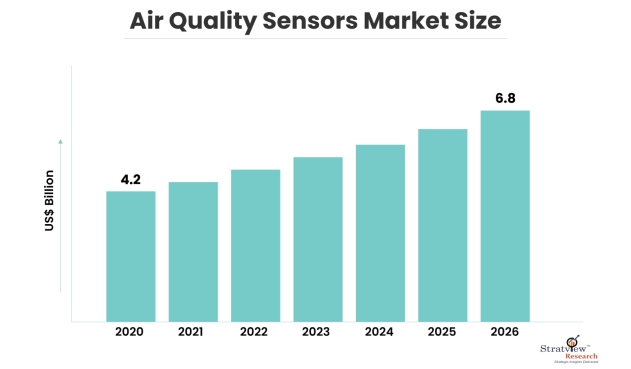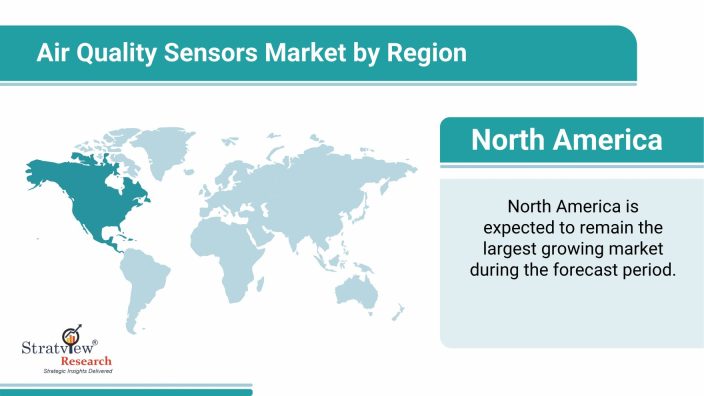Market Insights
"The global air quality sensors market is estimated to grow from USD 4.2 billion in 2020 to USD 6.8 billion by 2026 at a healthy CAGR of 8.6% during the forecast period."

Want to get a free sample? Register Here
Introduction
Air quality sensors are components used for purifying air or standalone devices, which can detect as well as monitor air pollution in the nearby area. Air quality sensors can be widely used for both indoor as well as outdoor environments. These sensors are available in numerous types, most of them focus on five components which include particulate matter, ozone, sulfur dioxide, carbon monoxide, and nitrous oxide.
Market Drivers
The air quality sensors market is mainly driven by:
- Rapid urbanization, increasing knowledge among the population regarding rising airborne diseases & fatalities, and economic & population growth.
- This has resulted in a surge in industrial activities, vehicle use, and energy consumption in various cities worldwide, which led to pervasive urban air pollution.
- Growing environmental pollution has become a key issue; governments at all levels globally, are paying more attention to environmental management in their jurisdictions and thus increasing the investment in environmental monitoring & emergency monitoring.
- Also, a soaring number of infrastructural projects in business & industrial areas.
COVID-19 Impact
The outbreak of COVID-19 negatively affected the air quality sensors industry. The shutdown of manufacturing activities along with the ban on travel & transportation across the globe, affected the demand for air quality sensors as there was less pollution due to limited emissions. Most automakers and other manufacturing sectors had to halt operations or are working at a limited capacity, thus adversely affecting product demand.
|
Air Quality Sensors Market Report Overview
|
|
Market Size in 2020
|
US$ 4.2 Bn
|
|
Market Size in 2026
|
US$ 6.8 Bn
|
|
CAGR (2021-2026)
|
8.6%
|
|
Base Year of Study
|
2020
|
|
Trend Period
|
2015-2019
|
|
Forecast Period
|
2021-2026
|
Segment Analysis
By Type
"The multi-gas monitoring system segment accounted for the largest market share."
The market has been bifurcated into signal-gas monitoring systems and multi-gas monitoring systems. The multi-gas monitoring system segment accounted for the largest market share in 2020. Increasing worries regarding personnel and plant security are the drives the need for multi-gas monitoring systems. The rising number of deadly mishaps, gas leaks, and spillages further augments the segment's growth.
Regional Insights
"North America accounted for the largest market share."
The North American market accounted for a significant share in 2020 and is expected to grow at a robust CAGR during the review period. The market growth is mainly propelled by growing awareness in individuals regarding air purifiers. Also, large presence of product manufacturers along with stringent environmental regulations on installation of air quality sensors, further bolsters the regional market growth. The Asia Pacific air quality sensors? market is expected to grow at a healthy CAGR during the review on account of growth of the major end-use industries. This growth is mainly attributed to infrastructure improvement of residential and commercial buildings as well as rapid industrialization and strong economic growth.

Want to get a free sample? Register Here
Key Players
Key players operating in the global air quality sensors market are:
- Foobot (US)
- Airbeam (AirCasting) (Canada)
- Air Guard K (US)
- Laser Egg (Switzerland)
- PRANUS (US)
- Birdi (US)
- CubeSensors (Slovenia)
- Haier (China)
- Honeywell International Inc. (US)
- Schneider Electric SE (France)
Note: The above list does not necessarily include all the top players in the market.
Are you the leading player in this market? We would love to include your name. Write to us at sales@stratviewresearch.com
Report Features
This report provides market intelligence most comprehensively. The report structure has been kept such that it offers maximum business value. It provides critical insights into market dynamics and will enable strategic decision-making for existing market players as well as those willing to enter the market.
What deliverables will you get in this report?
|
Key questions this report answers
|
Relevant contents in the report
|
|
How big is the sales opportunity?
|
In-depth analysis of the Air Quality Sensors Market
|
|
How lucrative is the future?
|
Market forecast and trend data and emerging trends
|
|
Which regions offer the best sales opportunities?
|
Global, regional and country level historical data and forecasts
|
|
Which are the most attractive market segments?
|
Market segment analysis and forecast
|
|
Which are the top players and their market positioning?
|
Competitive landscape analysis, Market share analysis
|
|
How complex is the business environment?
|
Porter’s five forces analysis, PEST analysis, Life cycle analysis
|
|
What are the factors affecting the market?
|
Drivers & challenges
|
|
Will I get the information on my specific requirement?
|
10% free customization
|
Research Methodology
This strategic assessment report, from Stratview Research, provides a comprehensive analysis that reflects today’s air quality sensors market realities and future market possibilities for the forecast period. The report segments and analyzes the market in the most detailed manner to provide a panoramic view of the market. The vital data/information provided in the report can play a crucial role for market participants as well as investors in the identification of the low-hanging fruits available in the market as well as to formulate growth strategies to expedite their growth process.
This report offers high-quality insights and is the outcome of a detailed research methodology comprising extensive secondary research, rigorous primary interviews with industry stakeholders, and validation and triangulation with Stratview Research’s internal database and statistical tools. More than 1,000 authenticated secondary sources, such as company annual reports, fact books, press releases, journals, investor presentations, white papers, patents, and articles, have been leveraged to gather the data. We conducted more than 15 detailed primary interviews with market players across the value chain in all four regions and industry experts to obtain both qualitative and quantitative insights.
Customization Options
With this detailed report, Stratview Research offers one of the following free customization options to our respectable clients:
Company Profiling
- Detailed profiling of additional market players (up to three players)
- SWOT analysis of key players (up to three players)
Competitive Benchmarking
- Benchmarking of key players on the following parameters: Product portfolio, geographical reach, regional presence, and strategic alliances
Custom Research: Stratview Research offers custom research services across sectors. In case of any custom research requirement related to market assessment, competitive benchmarking, sourcing and procurement, target screening, and others, please send your inquiry to sales@stratviewresearch.com

